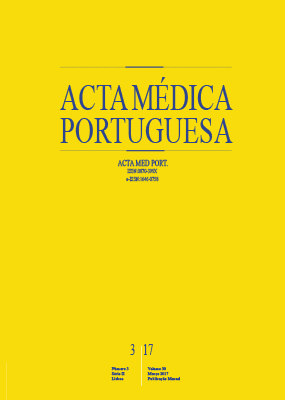Pediatric Cataracts: A Retrospective Study of 12 Years (2004 - 2016)
DOI:
https://doi.org/10.20344/amp.8223Keywords:
Adolescent, Cataract/epidemiology, Cataract/etiology, Cataract Extraction, ChildAbstract
Introduction: Cataracts are a major cause of preventable childhood blindness. Visual prognosis of these patients depends on a prompt therapeutic approach. Understanding pediatric cataracts epidemiology is of great importance for the implementation of programs of primary prevention and early diagnosis.
Material and Methods: We reviewed the clinical cases of pediatric cataracts diagnosed in the last 12 years at Hospital Pedro Hispano, in Porto.
Results: We identified 42 cases of pediatric cataracts with an equal gender distribution. The mean age at diagnosis was 6 years and 64.3% of patients had bilateral disease. Decreased visual acuity was the commonest presenting sign (36.8%) followed by leucocoria (26.3%). The etiology was unknown in 59.5% of cases and there was a slight predominance of nuclear type cataract (32.5%). Cataract was associated with systemic diseases in 23.8% of cases and with ocular abnormalities in 33.3% of cases. 47.6% of patients were treated surgically. Postoperative complications occurred in 35% of cases and posterior capsular opacification was the most common (25%).
Discussion: The report of 42 cases is probably the result of the low prevalence of cataracts in this age. Although the limitations of our study include small sample size, the profile of children with cataracts in our hospital has characteristics relatively similar to those described in the literature.
Conclusion: Given the high proportion of idiopathic pediatric cataracts, prevention of the disease remains a challenge worldwide.
Downloads
Downloads
Published
How to Cite
Issue
Section
License
All the articles published in the AMP are open access and comply with the requirements of funding agencies or academic institutions. The AMP is governed by the terms of the Creative Commons ‘Attribution – Non-Commercial Use - (CC-BY-NC)’ license, regarding the use by third parties.
It is the author’s responsibility to obtain approval for the reproduction of figures, tables, etc. from other publications.
Upon acceptance of an article for publication, the authors will be asked to complete the ICMJE “Copyright Liability and Copyright Sharing Statement “(http://www.actamedicaportuguesa.com/info/AMP-NormasPublicacao.pdf) and the “Declaration of Potential Conflicts of Interest” (http:// www.icmje.org/conflicts-of-interest). An e-mail will be sent to the corresponding author to acknowledge receipt of the manuscript.
After publication, the authors are authorised to make their articles available in repositories of their institutions of origin, as long as they always mention where they were published and according to the Creative Commons license.









